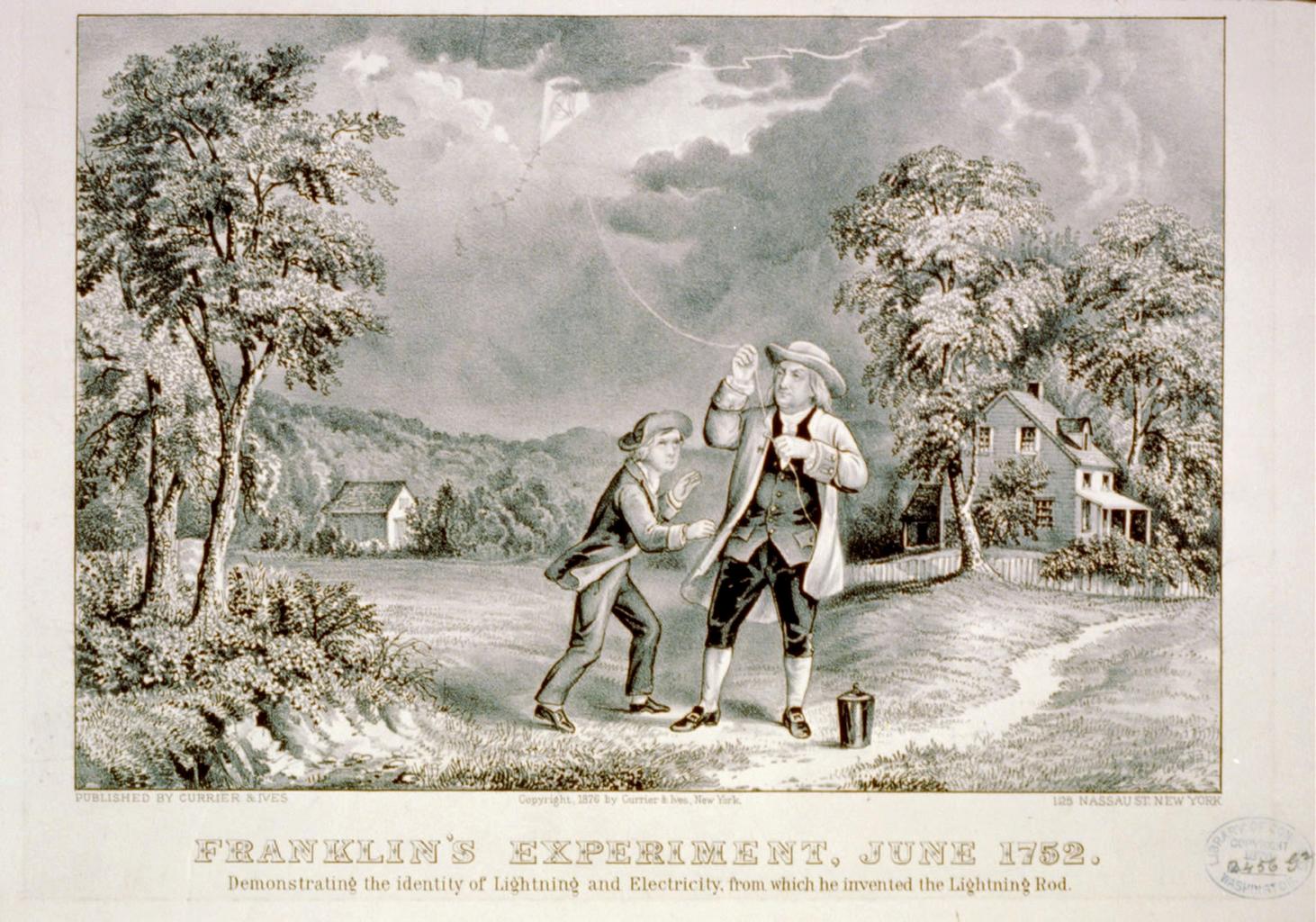Lightning conductor

|
| This 1876 Currier & Ives print depicts Franklin's kite experiment in June 1752. It's a fanciful illustration of Franklin's identity of lightning and electricity, from which he invented the lightning conductor. |
Contents |
[edit] Introduction
A lightning conductor (or lightning rod) is a metallic tip typically placed at the highest point of a building. Lightning conductors are most often made from conductive materials, such as copper and aluminium, and come in many different forms including hollow, solid, pointed, rounded, flat or brush shaped. Lightning conductors are also referred to as finials, air terminals or strike termination devices.
In the 1800s, some lighting conductors took on decorative characteristics, frequently topped with glass balls and weather vanes.
[edit] Origin
There are earlier examples of exploratory (or even unintentional) lightning conductors prior to the work of Benjamin Franklin. However, it was Franklin who made the formal connection between lightning and electricity. The Franklin Rod tested his theories as part of his ongoing investigations into the properties of electricity.
For his work with lightning conductors, Franklin explored using an iron pole sharpened to a point. He pursued this theory around the same time he proposed the idea of flying a kite with a key attached during an electrical storm.
[edit] How lightning conductors work
Lightning conductors do not prevent lightning strikes, they simply provide a low-resistance path to earth when strikes occur. In this way, the discharge is transmitted through the conductor instead of through the building so that the latter is protected from electrical and other damage, fire or injury to occupants.
To perform this function, the lightning conductor must be properly grounded. One or more types of conductors, often in the form of metal strips, are used to earth the structure. The conductors are sometimes provided with sharp points. At these points the paths of the electric field are closely concentrated so that ionisation of the air around the points takes place.
[edit] Related articles on Designing Buildings Wiki
Featured articles and news
Boiler Upgrade Scheme and certifications consultation
Summary of government consultation which closes 11 June 2025.
Deputy editor of AT, Tim Fraser, discusses the newly formed society with its current chair, Chris Halligan MCIAT.
Barratt Lo-E passivhaus standard homes planned enmasse
With an initial 728 Lo-E homes across two sites and many more planned for the future.
Government urged to uphold Warm Homes commitment
ECA and industry bodies write to Government concerning its 13.2 billion Warm Homes manifesto commitment.
Places of Worship in Britain and Ireland, 1929-1990. Book review.
The emancipation of women in art.
CIOB Construction Manager of the Year 2025
Just one of the winners at the CIOB Awards 2025.
Call for independent National Grenfell oversight mechanism
MHCLG share findings of Building Safety Inquiry in letter to Secretary of State and Minister for Building Safety.
The Architectural Technology Awards
AT Awards now open for this the sixth decade of CIAT.
50th Golden anniversary ECA Edmundson awards
Deadline for submissions Friday 30 May 2025.
The benefits of precast, off-site foundation systems
Top ten benefits of this notable innovation.
Encouraging individuals to take action saving water at home, work, and in their communities.
Takes a community to support mental health and wellbeing
The why of becoming a Mental Health Instructor explained.
Mental health awareness week 13-18 May
The theme is communities, they can provide a sense of belonging, safety, support in hard times, and a sense purpose.
Mental health support on the rise but workers still struggling
CIOB Understanding Mental Health in the Built Environment 2025 shows.
Design and construction material libraries
Material, sample, product or detail libraries a key component of any architectural design practice.
Construction Products Reform Green Paper and Consultation
Still time to respond as consultation closes on 21 May 2025.
Resilient façade systems for smog reduction in Shanghai
A technical approach using computer simulation and analysis of solar radiation, wind patterns, and ventilation.
























